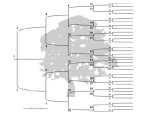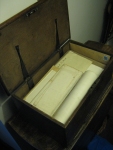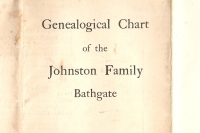It’s very easy to make false assumptions; but harder to get the real facts.
I’d like to tell a cautionary tale from my own research.
First some context; on occasions I’ve found other people’s family trees posted in various locations on the web, which appear to have connections to mine. They claim to have connections to the same ancestors. But there are some differences! Some “extra details” that are a surprise to me, or some clear discrepancies! So I try to contact the person who has posted the tree; to try and get more details and find out what their sources are; to see if it really does fit with my tree and whether there are new details that I can add to my tree.
Too often I’ve either had no response, or they are unable to explain the sources of their information. And too often people appear to have relied only on details obtained from the transcriptions of Parish registers (like the IGI), and to have assumed that the same “name” appearing in several places in the Parish register all relate to the same “Person”.
 I want to explain, from an example in my own research experience, why I believe that this particular approach is highly unreliable! And why I believe that more evidence is normally required!
I want to explain, from an example in my own research experience, why I believe that this particular approach is highly unreliable! And why I believe that more evidence is normally required!
It must be said that there is a scale to the reliability of this approach. If you’re dealing with particularly rare or unusual names then there may be a reasonable degree of reliability to this approach. But more often than not you’ll be dealing with relatively common names (both forenames and surnames), and here this approach is totally unreliable!
Remember also that in the past people rarely moved very far, unlike they do today. So it was very common to find extended families living geographically close together, and to find cousins or second cousins, or uncles/aunts & nephews/nieces, who shared the same names, living in the same parish. So, unless you can study the original text for un-transcribed details (which might confirm a continuity between different records), you can’t rely on a name that appears in the records on several occasions being a reference to the same person on each occasion. But also people did sometimes move, and the person you’re looking for may be married in a completely different parish to where they were christened.
 In my recent posts about Walker family papers, I have mentioned 2 examples (William Walker, b.1739, and Elizabeth Walker, b.1769) where trees posted by other people appear to have made assumptions from the Parish registers that the same “name” appearing in different places in the registers is the same “person”. But these associations seem to me to be at odds with the evidence that I have found in the original family papers that I have!
In my recent posts about Walker family papers, I have mentioned 2 examples (William Walker, b.1739, and Elizabeth Walker, b.1769) where trees posted by other people appear to have made assumptions from the Parish registers that the same “name” appearing in different places in the registers is the same “person”. But these associations seem to me to be at odds with the evidence that I have found in the original family papers that I have!
I have another example from the same family where I appear to have made the same kind of error! This demonstrates the unreliability of this approach, when there is no other evidence to support the assumptions being made!
When I uploaded my GEDCOM to FindMyPast (in Jan. 2016), I noticed that I had “Isabell Walker” (b. 23rd Aug 1729 in Kirkliston, West Lothian) recorded as marrying William Glass in May 1760. The “Walkers in Scotland” website lists the IGI transcriptions for the marriage like this;
- 16750 – Isobel WALKER, William GLASS, marr, 4 May 1760, Edinburgh Parish Edinburgh, Midlothian, 993527
- 16751 – Isobel WALKER, William GLASS, marr, 2 May 1760, Kirkliston West, Lothian, 1066630
The similarity of these 2 records means that they are almost certainly recording the same couple, registering their marriage in the parishes where each of them lived. This appears to be the only record for the marriage of an “Isobel Walker” (or similar name) recorded in the Kirkliston parish records. So at some point I appear to have associated this marriage with the Isabell Walker b. 23rd Aug 1729 in Kirkliston, to William Walker & Elizabeth Barron. I’m not sure if this came from seeing this association being made in someone else’s tree! But more likely, it’s an association that I had made myself!
 I know that I’ve not found any evidence for this association from among the family papers that I have, or from any other sources. So seeing it again through the FindMyPast Family Tree Builder made me question what evidence I had for it. Nothing except the transcribed Parish registers, it seems, which I don’t think is sufficient!
I know that I’ve not found any evidence for this association from among the family papers that I have, or from any other sources. So seeing it again through the FindMyPast Family Tree Builder made me question what evidence I had for it. Nothing except the transcribed Parish registers, it seems, which I don’t think is sufficient!
So last week I started searching on-line to see if I could find any more evidence that would prove (or disprove) this association. If I couldn’t find more evidence, then I intended to delete this association from my tree, as unreliable! But it would be important to keep a separate note of it being a possibility, for future reference and further research.
As it was, I soon found evidence that this association was completely false; that the “Isobel Walker” who married “William Glass” in 1760, could not be the daughter of William Walker & Elizabeth Barron, b. 1729. The first thing I found, from Google Books, was; “The General Correspondence of James Boswell, 1766-1769: 1768-1769”; a transcription of letters, published by Edinburgh University Press in 1997. On page 92, an editors’ end-note about one of James Boswell’s letters says the following;
“ Lady Jane’s serving-maids were Isobel or Isabella (‘Tibby’) Walker and Euphemia (‘Effy’) Caw. Walker (b. 1719), a naitive of Leith, re- mained in the service of Lady Jane until Lady Jane’s death. She later (c. 1759-62) became servant to William Hogg of Edinburgh and c. 1762 married William Glass, gardener at Newliston (Douglas memorial, pp. 130-31, 142; Hamilton Proof, p. 48).”
(“Lady Jane” was; Lady Jane Douglas, married to Sir John Stewart)
This indicates that the “Isobel Walker” who married William Glass was 10 years older than the daughter of William Walker & Elizabeth Barron. None of the described life events of this Isobel Walker appear to match with what I would expect to find for the Isabell Walker in my family tree! I wanted to find out more! I wanted to check out what the source of this note; the “Douglas memorial” actually said!
After a bit of web-searching, trying slightly varying terms, I found 2 contemporary records, digitised on Google Books, which mention the Isobel Walker who married William Glass;
- Memorial for Archibald Douglas of Douglas, Esq: And for Margaret, Dutchess of Douglas, and Charles, Duke of Queensberry and Dover, His Curators, Defenders; By Sir Ilay Campbell; 1766
- The Scots Magazine, Volume 25; Sands, Brymer, Murray and Cochran, 1763
The Memorial for Archibald Douglas contains numerous mentions of “Tibby Walker”, or “Ifobel Walker” (the “s” being replaced with an “f” – it was common in old handwriting to sometimes write an “s” like an “f”. This practice has been copied in the original print, and in the modern, digital transcription.). She is also identified in parts of the text as “Isabella Glass”, and “Mrs Glafs”.
It takes a while to read through these references and their contexts. There are 2 or 3 points where the text indicates that Isobel was “about the age of twenty-nine” (in 1748), and that she “was further advanced in years” than her colleague, Effy Caw, whose birth-date is identified in one place as “1st February 1727”. All this proves to me that this “Isobel Walker” (who married William Glass) is too old to be the “Isabell Walker” in my family tree, who was born in August 1729.
The point of this post is to show how easy it is to make false assumptions. It was unreliable for me to assume (without other evidence) that a name appearing more than once in the records of a parish related to the same person on each occasion. It may, more often, not be the case. I have tried this approach and proven it to be potentially faulty! But it seems to me that too many people take this kind of approach, or at least fail to provide sufficient details of any other evidence that they may have to support such assumptions.
The trouble I have is that when someone posts, publishes, or shares a family tree which contains this kind of assumption, these assumptions become “pseudo-facts” which people using the tree further down the line will treat as real, proven information.
 Take the Johnston family tree (published circa 1909). I have treated it all as fact. Looking at the tree, without other evidence to hand, you have no way of knowing if it all has evidence to prove it, or if any of it is based on assumptions (like those I’ve describe above) which may turn out to be false (if you could find the genuine evidence)! I do have other evidence which supports significant parts of the Johnston tree.
Take the Johnston family tree (published circa 1909). I have treated it all as fact. Looking at the tree, without other evidence to hand, you have no way of knowing if it all has evidence to prove it, or if any of it is based on assumptions (like those I’ve describe above) which may turn out to be false (if you could find the genuine evidence)! I do have other evidence which supports significant parts of the Johnston tree.
Likewise the genealogy of the “Barons of Preston” in “Some Old Families”, by Hardy Bertram McCall (published in 1890); you would probably take it on faith to be accurate! But due to the evidence that I have found in my family documents, I have some questions and doubts about that genealogy (expressed in my notes HERE).
I want my trees to be as accurate as possible; based on evidence rather than assumptions; facts rather than theories. I’m happy to discuss assumptions and theories (mine and other people’s), as you can already see from some of my blog posts. But I want to be really clear about what has evidence and what is assumed. I want to try and avoid including assumptions, that lack clear evidence, in any formal trees or genealogy reports that I post to this blog or publish anywhere else.
I hope that others will also want to be as clear in distinguishing between evidence and assumptions, and in providing reasonable evidence for their information.

Hi,
I want to let you know that your blog is listed in today’s Fab Finds post at http://janasgenealogyandfamilyhistory.blogspot.com/2016/03/follow-friday-fab-finds-for-march-4-2016.html
Have a great weekend!
LikeLike
Hi Jana
Thanks for the link.
LikeLike